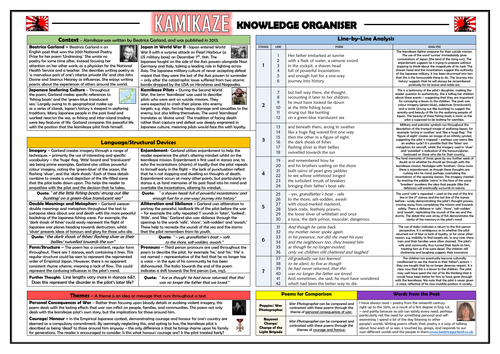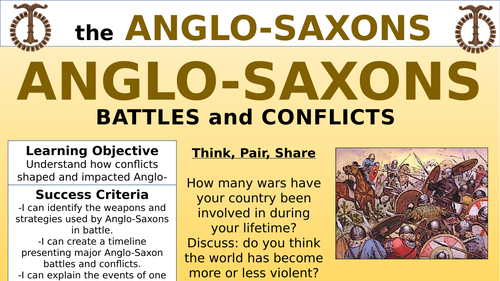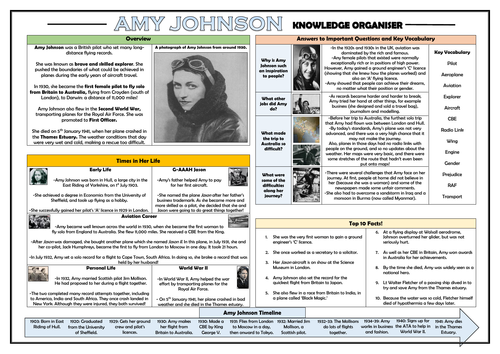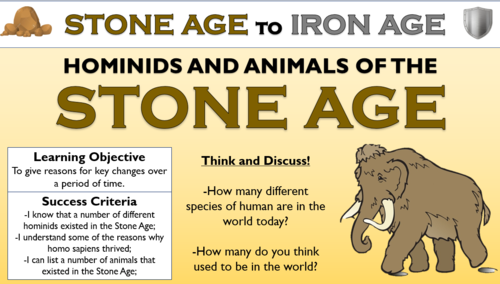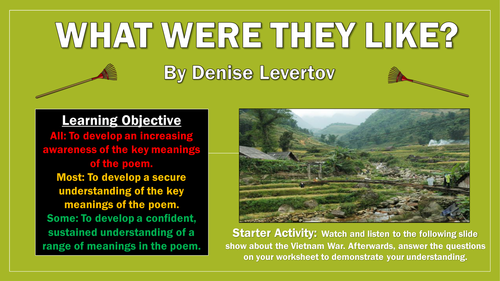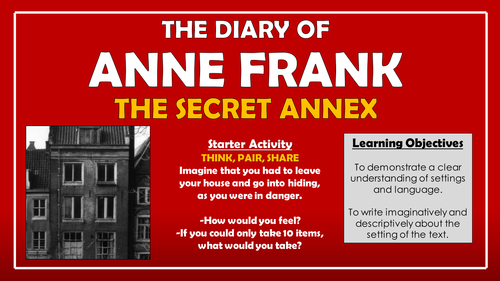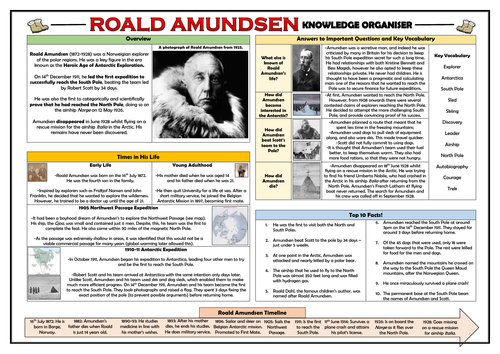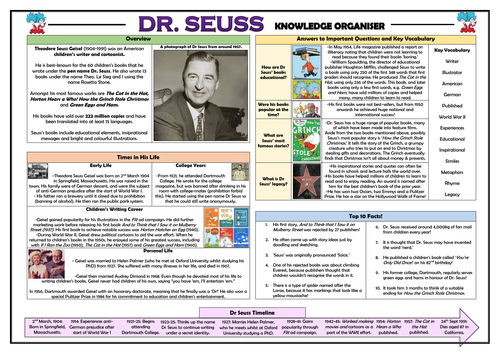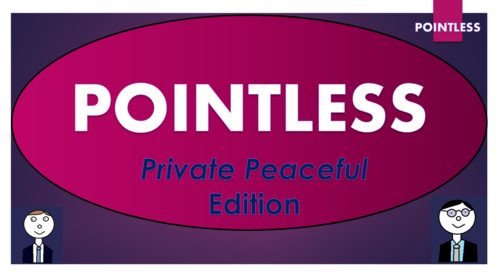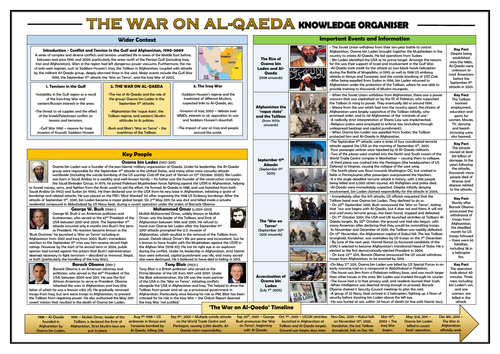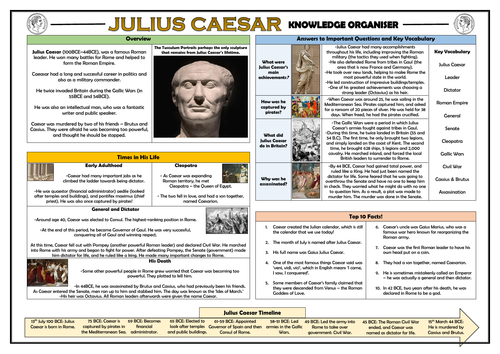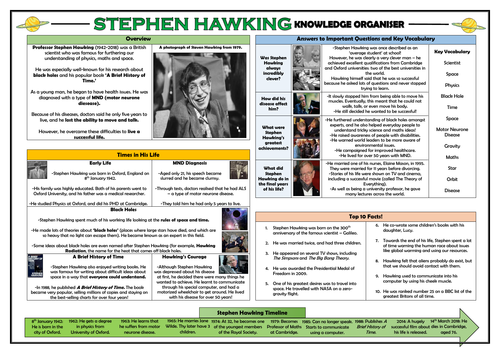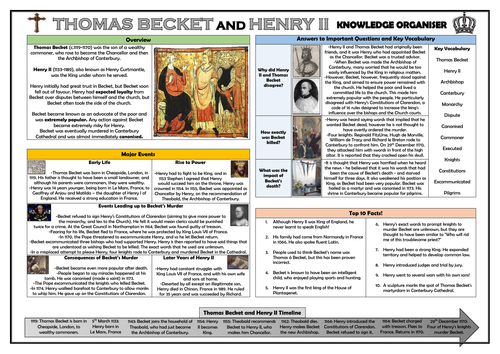
3k+Uploads
1874k+Views
2215k+Downloads
History

Kamikaze - Beatrice Garland - Knowledge Organiser/ Revision Mat!
This detailed and visually-appealing resource offers a complete reference point for students learning or revising Beatrice Garland’s power and conflict poem 'Kamikaze.’ It contains comprehensive sections on:
Context;
Line-by-Line Analysis;
Poetic Devices/ Language Devices;
Themes;
Form/Structure;
Poems for Comparison;
The Poet’s Influences.
Key words and ideas are underlined for easy reference. The resource is designed to be printed onto A3, and is provided as both a PDF and a Word version (so that you can edit if you want to). All images used are licensed for commercial use and are cited on a separate document (included).

Anglo-Saxons Battles and Conflicts - Double Lesson!
In this engaging lesson, children develop an understanding of the battles and conflicts fought by the Anglo-Saxons. In particular, they consider weapons and strategies used by Anglo-Saxon fighters and create a timeline of the major battles throughout the Anglo-Saxon period, The learning is guided by a clear and colourful PowerPoint presentation, which guides students through the following step-by-step journey:
-Knowledge recall - gauging what children already know about the Anglo-Saxon era (answers are provided);
-Understanding that life in Anglo-Saxon times was harsh and often violent, and that battles and conflicts were frequent;
-Studying sources to identify the types of weapons that were used by Anglo-Saxon warriors;
-Learning about some of the strategies adopted by Anglo-Saxon armies;
-Creating a timeline of the key battles throughout the Anglo-Saxon period (the information about these battles is provided);
-Completing their own extended research to find out more about one of the key battles;
-Considering how Anglo-Saxon battles helped to shape England;
-Self-reflecting on the extent to which they feel they have met the learning objective.
Included is the comprehensive PowerPoint presentation (22 slides) and the information cards for the timeline activity.
In the past, I have used this lesson with children in upper KS2 (years 5 and 6) - the key learning is aligned with curriculum expectations for history. All images are licensed for commercial use.

Amy Johnson Knowledge Organiser!
This clear, detailed and visually-appealing resource offers a complete reference point for children learning about the pilot Amy Johnson, particularly those completing a history study of ‘Significant Individuals.’ It contains comprehensive sections entitled:
Overview;
Times in Her Life;
Important Vocabulary;
Amy Johnson Timeline;
Answers to the Important Questions;
Top Ten Facts.
The resource is designed to be printed onto A3, and is provided as both a PDF and a Word version (so that you can edit if you want to). All images used are licensed for commercial use.

Stone Age to Iron Age - Hominids and Animals of the Stone Age!
In this engaging lesson, children learn about the different hominids and animals from the Stone Age, including:
-homo habilis
-homo erectus
-neanderthals
-homo sapiens
-woolly mammoths
-saber-toothed tigers
-dire wolves
The learning is guided by a clear and colourful PowerPoint presentation, which guides students through the following step-by-step journey:
-Knowledge recall - gauging what children know/ can remember about the Stone Age, including the three main periods;
-Using research methods to discover information about different species of early humans;
-Reading and comprehending information about the different animals of the time;
-Self-reflecting on the extent to which they feel they have met the learning objective.
Included is the comprehensive PowerPoint presentation (23 slides) and the research worksheet (in both Word and PDF)
In the past, I have used this lesson with children in lower KS2 (years 3 and 4) - the key learning is aligned with curriculum expectations for history. All images are licensed for commercial use.

Pointless - History - World War II Edition
Based on the popular game show 'Pointless', this resource is perfect for use as a starter activity, plenary, or revision tool. Editable, so that you can change to any other topic or change the questions/answers. Containing almost 30 slides of sound clips, engaging visuals, and suitably challenging questions, this resource is effective at both promoting engagement and enhancing learning.
There are several full rounds of questions to build students' understanding of World War II, including:
1. Naming the combatant countries involved in World War II.
2. Identifying the key leaders and protagonists for the major warring nations.
3. Remembering key dates of major events.
4. Recalling details of the D-Day landings.
The nature of the game ensures that this resource can challenge students of all levels.
NOTE: You can buy this resource alone, or in a bundle of 8 Pointless games, for only £1 more!

What Were They Like? Denise Levertov - Vietnam War Poem
These resources enable students to build their knowledge of the content, language, and structure of Denise Levertov’s Vietnam War poem ‘What Were They Like?’ In particular, students learn about the historical context of the Vietnam War. They also learn how features of language and structure aid the impact of the poem.
Students learn through a logical and step-by-step learning journey, including:
-Exploring the historical concept of the Vietnam War;
-Understanding key information about Denise Levertov and her life;
-Reading and interpreting the poem;
-Understanding the poem, with a particular emphasis upon the content, language, and structural features;
-Writing an extended analysis piece based upon how Levertov gets across her feelings about war in the poem, through the use of language and structure;
-Peer assessing each other's learning attempts.
Included is:
- Whole lesson PowerPoint - colourful and substantial; (including hyperlink to a reading of the poem)
- Copy of poem;
- Structural devices worksheet
- Analysis template with in-built success criteria for creating well-structured responses;
- Comprehensive lesson plan.
There are also opportunities for group learning, peer assessment, and whole class discussion. This was originally taught to middle-ability year 9/10 groups, but can easily be differentiated for groups of different ages and abilities.
All images are licensed for commercial use, and image rights are listed on the last page of the presentation.

The Diary of Anne Frank - Anne's Use of Language
This engaging and informative lesson helps students to demonstrate a clear understanding of the descriptive language used by Anne Frank in her ‘Diary of a Young Girl.’ Students explore how Anne uses techniques such as varied vocabulary, personification, and metaphors to describe scenes and events to the audience. Students also have a go at using their own imaginative language devices through their own diary entries.
The lesson follows a step-by-step learning journey, in which children learn through:
-Completing a card-sorting activity to define and exemplify each of the descriptive devices;
- Reading and understanding extracts from a section of Anne Frank's Diary, in which Anne describes her fear during a bombing, and her anger with her fellow annex inhabitants;
- Identifying and analysing Anne's use of language devices throughout the extract;
- Writing their own language device-filled diary attempts, with support from a helpsheet and a model example;
- Self assessing their own learning attempts.
Included is:
- Whole lesson PowerPoint - colourful and comprehensive;
- Anne's Language Devices Worksheet (and answer sheet);
- Selected extracts - The Diary of Anne Frank;
- Cards for sorting activity;
- Writing to Describe Helpsheet;
- Comprehensive lesson plan.
There are also opportunities for group learning, speaking and listening, peer assessment, and whole class discussion. I originally used these resources with a mixed-ability year 8 class, however colleagues have used them for between years 5 and 9 with minimal adaptations.
All images are licensed for commercial use, and image rights are listed on the last page of the presentation.

The Diary of Anne Frank - The Secret Annex
This engaging and informative lesson helps students to demonstrate a clear understanding of the setting in ‘The Diary of Anne Frank’ - The Secret Annex. Students explore the language used by Anne Frank in her description, explore the annex for themselves on a virtual tour, and then write imaginative and original descriptions based on what they have seen and read.
The lesson follows a step-by-step learning journey, in which children learn through:
-Empathising with the Frank family's situation by discussing the idea of displacement;
- Reading and understanding extracts from the opening section of Anne Frank's Diary, in which Anne describes the annex;
- Information gathering on each of the rooms in the annex through observing a virtual tour;
- Linking information and using imaginative thoughts to produce detailed, original, and imaginative descriptions of rooms in the annex;
- Self assessing their own learning attempts.
Included is:
- Whole lesson PowerPoint - colourful and comprehensive;
- Information Gathering Template;
- Selected extracts - The Diary of Anne Frank;
- Link to a virtual tour video (you will need internet access to view);
- Writing to Describe Helpsheet;
- Comprehensive lesson plan.
There are also opportunities for group learning, speaking and listening, peer assessment, and whole class discussion. I originally used these resources with a mixed-ability year 8 class, however colleagues have used them for between years 5 and 9 with minimal adaptations. Please note that internet access/ use of research mechanisms is required for the introduction task.
All images are licensed for commercial use, and image rights are listed on the last page of the presentation.

Vergissmeinnicht Knowledge Organiser/ Revision Mat!
This detailed and visually-appealing resource offers a complete reference point for students learning or revising Keith Douglas’ war poem 'Vergissmeinnicht.’ It contains comprehensive sections on:
Context;
Line-by-Line Analysis;
Poetic Devices/ Language Devices;
Themes;
Form/Structure;
Poems for Comparison;
Links to Wider Reading.
Key words and ideas are underlined for easy reference. The resource is designed to be printed onto A3, and is provided as both a PDF and a Word version (so that you can edit if you want to). All images used are licensed for commercial use and are cited on a separate document (included).

Roald Amundsen - Knowledge Organiser!
This clear, detailed and visually-appealing resource offers a complete reference point for children learning about Roald Amundsen as a part of their history study of ‘Significant Individuals.’ It contains comprehensive sections entitled:
Overview;
Times in His Life;
Important Vocabulary;
Roald Amundsen Timeline;
Answers to the Important Questions;
Top Ten Facts.
The resource is designed to be printed onto A3, and is provided as both a PDF and a Word version (so that you can edit if you want to). All images used are licensed for commercial use.

Edmund Hillary - Knowledge Organiser!
This clear, detailed and visually-appealing resource offers a complete reference point for children learning about Sir Edmund Hillary, particularly those studying ‘Significant Individuals’ in history. It contains comprehensive sections entitled:
Overview;
Times in His Life;
Important Vocabulary;
Edmund Hillary Timeline;
Answers to the Important Questions;
Top Ten Facts.
The resource is designed to be printed onto A3, and is provided as both a PDF and a Word version (so that you can edit if you want to). All images used are licensed for commercial use.

Geoffrey Chaucer Knowledge Organiser!
This clear, detailed and visually-appealing resource offers a complete reference point for children learning about Geoffrey Chaucer. It is particularly useful for those completing a history study of ‘Significant Individuals.’ It contains comprehensive sections entitled:
Overview;
Times in his Life;
Important Vocabulary;
Geoffrey Chaucer Timeline;
Answers to the Important Questions;
Top Ten Facts.
The resource is designed to be printed onto A3, and is provided as both a PDF and a Word version (so that you can edit if you want to). All images used are licensed for commercial use.

Dr. Seuss Knowledge Organiser!
This clear, detailed and visually-appealing resource offers a complete reference point for children learning about Dr. Seuss, particularly those completing a history study of ‘Significant Individuals’ or those learning about prominent children’s authors. It contains comprehensive sections entitled:
Overview;
Times in His Life;
Important Vocabulary;
Dr. Seuss Timeline;
Answers to the Important Questions;
Top Ten Facts.
The resource is designed to be printed onto A3, and is provided as both a PDF and a Word version (so that you can edit if you want to). All images used are licensed for commercial use.

Private Peaceful Pointless Game (and template to create your own games!)
Based on the popular game show 'Pointless', this resource is perfect for use as a whole lesson resource, enrichment option, or revision tool. Editable, so that you can change to any other topic or change questions. (I've also added a blank template so that you can make your own games from scratch). Containing almost 30 slides of sound clips, interesting tasks, and suitably challenging questions, this resource is effective at both promoting engagement and enhancing learning. There are several full rounds of questions to build or revisit knowledge of characters, plot, and themes in 'Private Peaceful.'
Round 1. The characters in Private Peaceful
Round 2. Quotations from the text
Round 3. Settings and Objects
Round 4. Themes in Private Peaceful
The nature of this game ensures that the resource can challenge students of all levels.
A blank template has also been added, so that you can create your own games!

KS1 Great Fire of London Knowledge Organiser/ Revision Mat!
This clear, detailed and visually-appealing resource offers a complete reference point for KS1 children learning or revising knowledge relating to the The Great Fire of London. It contains comprehensive sections on:
The Great Fire of London Overview;
Map and description of the Affected Areas;
Key People;
The Great Fire of London Timeline;
Answers to the Important Questions;
Top Ten Facts.
The resource is designed to be printed onto A3, and is provided as both a PDF and a Word version (so that you can edit if you want to). All images used are licensed for commercial use and are cited on a separate document (included).

The War on Al-Qaeda - Knowledge Organiser/ Revision Mat!
This detailed and visually-appealing resource offers a complete reference point for students learning or revising knowledge of The War on Al-Qaeda. This is an important component in history modules covering ‘Conflict and Tension in the Gulf and Afghanistan, 1990-2009.’ It contains comprehensive sections on:
Major Events - dates, images, descriptions, and key facts - including the rise of Osama bin Laden and Al-Qaeda, Afghanistan ‘the rogue state’ and the Taliban, the September 11th attacks, the ‘War on Terror’ and the assassination of Osama bin Laden;
Key People - Osama bin Laden, George W. Bush, Mullah Omar, Barack Obama and Tony Blair.
Context - Conflict and Tension in the Gulf and Afghanistan Overview and Map;
Timeline of Major Events.
Key words and ideas are underlined for easy reference. The resource is designed to be printed onto A3, and is provided as both a PDF and a Word version (so that you can edit if you want to). All images are from Wikimedia Commons and are licensed for commercial use.

Julius Caesar Knowledge Organiser!
This clear, detailed and visually-appealing resource offers a complete reference point for children learning about Julius Caesar. It is particularly useful for those completing a history study of ‘Significant Individuals.’ It contains comprehensive sections entitled:
Overview;
Times in His Life;
Important Vocabulary;
Julius Caesar Timeline;
Answers to the Important Questions;
Top Ten Facts.
The resource is designed to be printed onto A3, and is provided as both a PDF and a Word version (so that you can edit if you want to). All images used are licensed for commercial use.

Stone Age Britain - Non-Fiction Whole Class Reading Session!
This whole class reading session aims to develop children’s comprehension skills through a reading of a non-fiction text about Stone Age Britain.
The resource pack includes the full text and all of the activities for the session, which the class are guided through via a comprehensive PowerPoint presentation. The reading is followed by a series of activities aiming to develop children’s retrieval, explanation, inference, prediction and summarising skills. It also contains a vocabulary check immediately after the extract is read to clarify any unfamiliar/ difficult language.
The tasks are comprised of quick-check questions, solo thinking, pair/ group discussions and deeper thinking activities.
The session is best suited for children in lower KS2, although with minor adaptations it could feasibly be used with slightly older or younger year groups. This resource is suitable for home/ remote learning. These resources are also suitable for home/ remote learning.

Stephen Hawking Knowledge Organiser!
This clear, detailed and visually-appealing resource offers a complete reference point for children learning about Professor Stephen Hawking as a part of their history study of ‘Significant People.’ It contains comprehensive sections entitled:
Overview;
Times in His Life;
Important Vocabulary;
Stephen Hawking Timeline;
Answers to the Important Questions;
Top Ten Facts.
The resource is designed to be printed onto A3, and is provided as both a PDF and a Word version (so that you can edit if you want to). All images used are licensed for commercial use.

Thomas Becket and Henry II - Knowledge Organiser!
This clear, detailed and visually-appealing resource offers a complete reference point for children learning about Thomas Becket and Henry II. It includes details of their lives leading up to and including the murder of Becket in 1170. It contains comprehensive sections entitled:
Overview;
Major Events;
Important Vocabulary;
Thomas Becket and Henry II Timeline;
Answers to the Important Questions;
Top Ten Facts.
The resource is designed to be printed onto A3, and is provided as both a PDF and a Word version (so that you can edit if you want to). All images used are licensed for commercial use.

